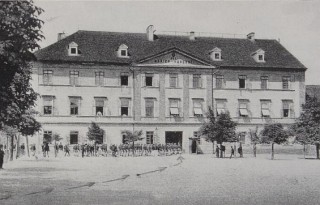
Mariánská kasárna in CB (Budweis). Until 1 June 1915 it was the home of the Good Soldier Švejk's Infanterieregiment Nr. 91. In 1915 Jaroslav Hašek also served with the regiment in these barracks.
The novel The Good Soldier Švejk refers to a number of institutions and firms, public as well as private. On these pages they were until 15 September 2013 categorised as 'Places'. This only partly makes sense as this type of entity can not always be associated with fixed geographical points, in the way that for instance cities, mountains and rivers can. This new page contains military and civilian institutions (including army units, regiments etc.), organisations, hotels, public houses, newspapers and magazines.
The line between this page and "Places" is blurred, churches do for instance rarely change location, but are still included here. Therefore Prague and Vienna will still be found in the "Places" database, because these have constant coordinates. On the other hand institutions may change location: Odvodní komise and Bendlovka are not unequivocal geographical terms so they will from now on appear on this page.
The names are colour coded according to their role in the plot, illustrated by these examples: U kalicha as a location where the plot takes place, k.u.k. Kriegsministerium mentioned in the narrative, Pražské úřední listy as part of a dialogue, and Stoletá kavárna, mentioned in an anecdote.
 Institutions index of institutions, taverns, military units, societies, periodicals ... (288)
Show all
Institutions index of institutions, taverns, military units, societies, periodicals ... (288)
Show all I. In the rear
I. In the rear  14. Švejk as military servant to senior lieutenant Lukáš (14)
14. Švejk as military servant to senior lieutenant Lukáš (14) II. At the front
II. At the front  1. Švejk's mishaps on the train (15)
1. Švejk's mishaps on the train (15) 2. Švejk's budějovická anabasis (38)
2. Švejk's budějovická anabasis (38) 3. Švejk's happenings in Királyhida (44)
3. Švejk's happenings in Királyhida (44) 4. New afflictions (26)
4. New afflictions (26)



|
III. The famous thrashing |
 | |
1. Across Magyaria | |||
 | Bruck-Királyhida pályaudvar |  | ||||
| ||||||
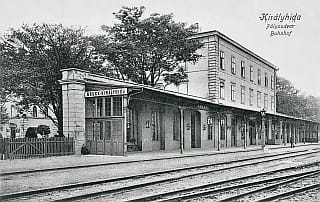

From Jan Vaněk's diary, 2 July 1915
Bruck-Királyhida pályaudvar is the scene of Švejk's march company's departure to the front, the date seems to have been 22 May 1915. The station is not mentioned explicitly in the narrative but the plot will necessarily have taken place here.
Background
Bruck-Királyhida pályaudvar was the railway station in Királyhida, opened in 1846. It is now officially called Bruck/Leitha Bahnhof. The old station building was demolished a long time ago.
It was from where Jaroslav Hašek's XII. Marschbataillon departed from on 30 June 1915 at 8:15 PM. They arrived at the front near Gołogóry on 11 July.
Jan Vaněk, deník 2.7.1915
Když jsem v březnu putoval do špitálu, nepomyslel jsem si, že v červenci se budu zase těmi samými místy vracet do pole. Vyjeli jsme 30. června večer o 1/4 9 hod. z Brucku. Chtěli nám ten těžký moment loučení osladit. Znají dobře svoje lidi, co žádají a co na ně platí, Dali nám na nádraží—muziku—.
Quote(s) from the novel
[III.1] Konečně se všichni dočkali toho okamžiku, kdy je nacpali do vagonů v poměru 42 mužů k 8 koním. Koním ovšem se jelo pohodlněji než mužstvu, poněvadž mohli spát vstoje, ale to nevadilo. Vojenský vlak vezl do Haliče opět novou skupinu lidí hnaných na jatky. Celkem však se všem těm tvorům přece jen ulehčilo; bylo to něco již určitého, když se vlak hnul, ale předtím to byla jen trapná nejistota, panika, zdali se pojede již dnes, nebo zítra, či pozítří. Některým bylo jako odsouzeným k smrti, kteří očekávají se strachem, kdy si pro ně přijde kat. A potom nastane uklidnění, že už to bude odbyto.
Literature
- Válečný deník Jana Vaňka, ,2014
 | Kriegskalender |  | |||
| |||||
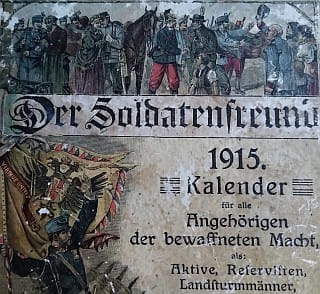
Kriegskalender is mentioned by the author when he comments on Feldoberkurat Ibl's field sermon before Švejk's march battalion departs from Bruck. He notes that the speech clearly was picked from war calendars.
Background
Kriegskalender in the context of The Good Soldier Švejk the author no doubt refers to "Der Soldatenfreund. 1915 Kalender". The quoted field sermon by Feldoberkurat Ibl is adapted from pages 72 and 73 of this calendar.
Der Soldatenfreund was a series of calendars that were published by the firm J. Steinbrener from 1892 until 1919. The calendar was issued in several of the languages of the empire: German, Hungarian, Czech, Polish... Steinbrener were headquartered in Winterberg (now Vimperk) in the Šumava region, but were represented also elsewhere in Austria-Hungary and even in New York.
The title page sounded: Der Soldatenfreund Kalender für das Jahr 1915. Für alle Angehörigen der bewaffneten Macht als: Aktive, Reservisten, Landsturmmänner, sowie für Veteranen und ehemalige Soldaten, und für alle Freunde des Soldatenstandes.
Hašek and war calendars
Radko Pytlík notes in Kniha o Švejkovi (1982) p. 87 that Hašek had publisher Synek send old Austrian calendars to Lipnice and Feldoberkurat Ibl's field mass indicates that he fitted elements from at least one of them into The Good Soldier Švejk. Looking for further fragments we have browsed the calendars from 1914 to 1919. The mentioned entry from the 1915 issue is obvious but the issue from 1919 is even more relevant as it identifies no less than six characters associated with Švejk's involuntary stay at Táborské nádraží in [II.1].
Der Soldatenfreund. Kalender für das Jahr 1919
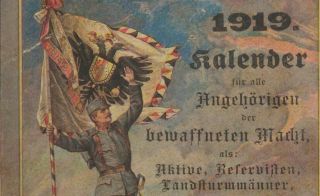

The inspiration for the propaganda posters that Švejk observed in Tábor is no doubt Kriegskalender, or more precisely: Der Soldatenfreund. Kalender für das Jahr 1919 and probably the Czech version of it. The reason that we can be so sure is that all the four motifs (six persons) that are described in this sequence of The Good Soldier Švejk also feature in the calendar. In addition, the text sequences that Hašek uses are more or less to the letter copies of text fragments from the calendar. In the case of Doctor Vojna even a spelling mistake in the surname found its way into The Good Soldier Švejk.
The motifs are fetched from pages 6 to 29 which is a pure calendar section. For each month there are two pages presenting a "shining role model of courage and gallantry". One page contains a drawing with a brief subtitle and on the next page there is a textual description of the heroic deed.
In the case of Zugsführer Danko and Zugsführer Hammel (with Korporal Paulhart and Korporal Bachmayer) the short subtitles are reproduced as is. In the case of Trainsoldat Bong, the entire description is copied almost to the letter. For Doctor Vojna it was different: only brief extracts from the description found their way into The Good Soldier Švejk and the soldier's vivid imagination provided the rest.
Quote(s) from the novel
[III.1] Měl přitom velice nadšenou řeč a bylo znát, že bral materiál z vojenských kalendářů.
Literature
 | Klárův ústav slepců |  | |||
| |||||

Klárův ústav slepců was the institution where the cook who replaced cook Jurajda in the officers mess at Királyhida hailed from.
Background
Klárův ústav slepců (Klárov Institute of the Blind) was from 1832 to 1945 an institute for the blind, now the location of Česká geologická služba (Czech Geology Service). The institute was founded by and is named after Alois Klar.
Quote(s) from the novel
[III.1] Toto psaní bylo vynuceno okolnostmi, když kuchař okultista nadobro si rozlil ocet s plukovníkem Schröderem, který mu dosud držel palec, ale na kterého se při večeři na rozloučenou s důstojníky maršbatalionu opět, nešťastnou náhodou, nedostala porce rolované telecí ledviny, a plukovník Schröder ho poslal s marškumpačkou do pole, svěřiv důstojnickou kuchyni pluku nějakému nešťastnému učiteli z ústavu slepců na Klárově.
Also written:Klárov Institute of the BlindenKlárov Blindeinstituttno
 | Průmyslová jednota |  | |||
| Praha I./539, Rytířská ul. 31 | |||||
| |||||
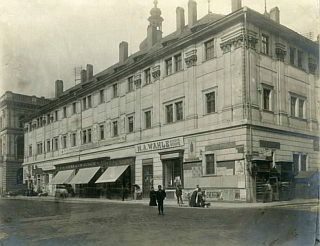
Průmyslová jednota in Prague is mentioned by Švejk because he once was refused admission in the reading room there due to his shabby appearance.
Background
Průmyslová jednota was an institution for promotion of technical education. It was founded in 1833 and was closed in 1950. The library and reading room in question was located in Rytířská ulice i Staré město.
Quote(s) from the novel
[III.1] „Vo tom stěhování duší jsem už taky slyšel,“ ozval se Švejk. „Já jsem si také jednou umínil před léty, že se, jak se s vodpuštěním říká, sám budu vzdělávat, abych nezůstal pozadu, a chodil jsem do čítárny Průmyslové jednoty v Praze, ale poněvadž jsem byl roztrhanej a svítily mně díry na zadnici, tak jsem se nemoh vzdělávat, poněvadž mne tam nepustili a vyvedli ven, poněvadž myslili, že jsem šel krást zimníky.
Credit: Milan Hodík, Radko Pytlík
 | Daňkovka |  | |||
| |||||
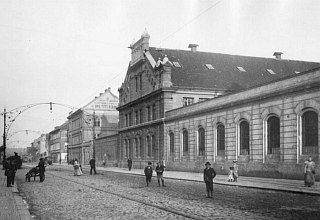
Paláckého třída towards the east with the main gate of Breitfeld-Daněk to the right. Around 1900.
© AHMP
Daňkovka was the factory where the metal caster metal caster Adamec worked. This is in an anecdote Švejk tells Oberleutnant Lukáš, but the latter cuts off.
Background
Daňkovka refers to the industrial group Breitfeld-Daněk a spol. that in 1927 was merged with Českomoravská-Kolben, a.s. to ČKD, a company that still exists. The Tatra tram is probably their best known product, still running in many of the former socialist countries. The first factory was located in Karlín and this is surely the one referred to by Švejk. See also negro Kristian.
Quote(s) from the novel
[III.1] Nadporučík Lukáš mluvil takovým hlasem, jako by se o něho pokoušela horečka, a toho okamžiku, když umlkl, využitkoval Švejk k nevinné otázce: „Poslušně hlásím, pane obrlajtnant, za prominutí, proč se nikdy nedozvím, co jsem vyved hroznýho: Já, pane obrlajtnant, jsem se vopovážil na to zeptat jenom kvůli tomu, abych se příště mohl takový věci vystříhat, když se všeobecně povídá, že se vod chyby člověk učí, jako ten slejvač Adamec z Daňkovky, když se vomylem napil solný kyseliny...“
 | Wiener Illustrierte Zeitung |  | |||
| Wien VI./-, Gumpendorfer str. 87 | |||||
| |||||

The front page of the first issue, 19.12.1914
Wiener Illustrierte Zeitung is mentioned when the author describes Kadett Biegler's dream on the train to Budapest. The landscape the cadet experiences in the dream is as cut out of this magazine.
Background
Wiener Illustrierte Zeitung was an illustrated weekly that was published every Saturday. The first issue appeared on 19 December 1914. The magazine continued to the end of 1916, altogether 107 issues. In the address book of 1917 the paper is not listed. The emphasis was on pictures from the war, celebrities, and patriotic propaganda, and the photos were for that time of good quality.
The paper was published by Gesellschaft für grafische Industrie, located in the city district of Mariahilf (VI. Bezirk) near the centre of Vienna.
Vídeňské illustrované noviny
A Czech weekly with the same title was also published in Vienna. This is however an entirely different periodical and was in circulation much longer, from 1906 to 1920.
Quote(s) from the novel
[III.1] Krajina měla týž ráz jako na obrázcích „Wiener Illustrierte Zeitung“. Po pravé straně bylo vidět u stodoly dělostřelectvo, jak střílí do nepřátelských zákopů vedle silnice, po které projížděl s automobilem.
Literature
- Verzeichnis der in Wien erscheinende Zeitungen, ,1914
- Vídeňské illustrované noviny, ,1906-1920
 | C.F. Amelang’s Verlag |  | |||
| Leipzig/-, Königstrasse 33 | |||||
| |||||

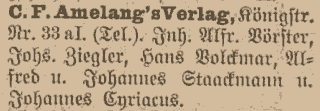
Leipziger Adreß-Buch, 1915
C.F. Amelang’s Verlag is mentioned in a footnote by the author, as the publishing house in Leipzig that published the book Self Education for death for the Emperor by Udo Kraft.
Background
C.F. Amelang’s Verlag was a publishing house head-quartered in Leipzig. They specialised in school text books, pedagogy, and history of literature. The firm was founded by Carl Friedrich Amelang (1785–1856) in 1806, but by 1915 the ownership was no longer with the family.
Newspaper items from the early years indicate that they were established in Berlin as a bookshop, and traded from there until 1850 when they appear to have moved to Leipzig. In 1853 it seems that the ownership has been passed to a certain Fr. Volckmar, and Hans Volckmar is listed as co-proprietor in 1915.
From 1917 to 1924 they gradually merged with other publishers to become Koehler & Amelang GmbH, a company that still exists.
Quote(s) from the novel
[III.1] Udo Kraft: Selbsterziehung zum Tod Für Kaiser. C.F. Amelang’s Verlag, Leipzig.
Literature
- Korrespondenz-Nachrichten, ,14.10.1808
- Bei C.F. Amelang in Berlin ..., ,10.7.1810
- In der Buchhandlung von Carl Friedrich Amelang in Berlin ..., ,12.11.1816
- Einladung zur Pränumeration, ,8.6.1850



|
III. The famous thrashing |
 | |
1. Across Magyaria | |||
| © 2008 - 2024 Jomar Hønsi | Last updated: 20.11.2024 |


